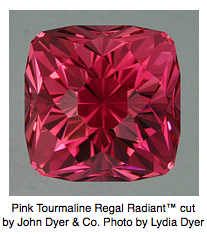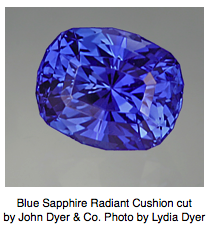Gemstone Prices and Their Potential to Rise.
Gemstone pricing is sort of a complex subject.
 In
very general terms the price of gems tends to rise over time (as do the
prices of most products except those that can readily have their
production industrialized). Gems probably have more upward pressure on
their prices than most products though due to a number of factors. The
wages in many of the producing countries are rising significantly as is
the cost of diesel fuel used by the generators and pumps used in
mining, at the same time environmental regulations are being strongly
enforced in Brazil and somewhat in Sri Lanka (which has banned mechanized mining) and other producing
countries so less material is being produced and at a higher cost.
In
very general terms the price of gems tends to rise over time (as do the
prices of most products except those that can readily have their
production industrialized). Gems probably have more upward pressure on
their prices than most products though due to a number of factors. The
wages in many of the producing countries are rising significantly as is
the cost of diesel fuel used by the generators and pumps used in
mining, at the same time environmental regulations are being strongly
enforced in Brazil and somewhat in Sri Lanka (which has banned mechanized mining) and other producing
countries so less material is being produced and at a higher cost.
The demand from Asia especially and to a lesser extent Latin America and Russia is increasing a lot. Asia has a huge number of people with increasing wealth and that makes them a new and large market (especially China and India of late). This increase in demand from new markets puts significant upward pressure on prices in addition to the already difficult mining situation. The main reason that gemstone prices have not increased more is that the largest buyer (the USA) has been having economic problems for a few years now and things in Europe are uncertain economically too.
That having been said the prices on some materials are currently rising very quickly. Certain sizes an d qualities of diamonds have gone up a lot, bicolor tourmaline especially
in large sizes has shot through the roof, large tourmaline in general
is hard to get and much higher in price. Chinese preference in
tourmaline is for Bicolor, Red, Pink, Blue, Blue Green and Green
tourmaline more or less in that order (especially in 8-10ct or larger
sizes, they will buy huge gems). They are buying not just for jewelry
use but for investments as evidently their government limits the kinds
of assets they can own but gems are allowed or readily concealable.
qualities of diamonds have gone up a lot, bicolor tourmaline especially
in large sizes has shot through the roof, large tourmaline in general
is hard to get and much higher in price. Chinese preference in
tourmaline is for Bicolor, Red, Pink, Blue, Blue Green and Green
tourmaline more or less in that order (especially in 8-10ct or larger
sizes, they will buy huge gems). They are buying not just for jewelry
use but for investments as evidently their government limits the kinds
of assets they can own but gems are allowed or readily concealable.
Prices are also rising rapidly on larger finer sapphires (especially 3 carat plus), rubies and somewhat on fine emeralds too. Supplies have tightened a lot on these materials and if the market in the US was strong right now the price jumps would be astronomical, as it is they are still pretty large.
As an example, my cost on some sapphires have risen about 30-60% just in the last few months. Large bicolor tourmaline is reported to have sold (in the rough) for up to 6.5 times the most I have been accustomed to paying in the past and other large tourmalines are also hard to get.
 The
main thing that can interrupt this upward trend is the periodic large
find of new material. (Or a huge drop in demand for some reason, this
is much less common.) This increased supply has happened numerous times
in history with the finds of Spessartite and Tourmaline of various
colors in Nigeria within the last 10 years being good examples. Usually
the prices get really depressed for a year or two and then gradually
return to their former levels. In almost all cases supplies from the
new find drops off due to depletion of the most easily mined material,
government or landowner intervention or other reasons. Rubelite and
Spessartite for example recovered their former value in about 4-6 years
or so and are now higher priced than they were before the new finds.
The
main thing that can interrupt this upward trend is the periodic large
find of new material. (Or a huge drop in demand for some reason, this
is much less common.) This increased supply has happened numerous times
in history with the finds of Spessartite and Tourmaline of various
colors in Nigeria within the last 10 years being good examples. Usually
the prices get really depressed for a year or two and then gradually
return to their former levels. In almost all cases supplies from the
new find drops off due to depletion of the most easily mined material,
government or landowner intervention or other reasons. Rubelite and
Spessartite for example recovered their former value in about 4-6 years
or so and are now higher priced than they were before the new finds.
All that having been said gems are not the greatest investment at times if you are not in the business because they can be hard to re sell. Your gem may be worth 2-3 times what you bought it for but that is just a theoretical value unless you can actually find someone who wants to buy it. So if you are buying for a jewelry business or for your own use then you can buy now and be happy that the price is very likely to be significantly higher in the future. However, unless you are in the business and know the ins and outs reselling can be quite tricky so these rising prices are most likely to benefit those who deal in gems and jewelry already.
By John Dyer
Winner of 55 gem cutting awards.
www.johndyergems.com
John Dyer & Co.
AGTA Firm Member
Gemstone pricing is sort of a complex subject.
 In
very general terms the price of gems tends to rise over time (as do the
prices of most products except those that can readily have their
production industrialized). Gems probably have more upward pressure on
their prices than most products though due to a number of factors. The
wages in many of the producing countries are rising significantly as is
the cost of diesel fuel used by the generators and pumps used in
mining, at the same time environmental regulations are being strongly
enforced in Brazil and somewhat in Sri Lanka (which has banned mechanized mining) and other producing
countries so less material is being produced and at a higher cost.
In
very general terms the price of gems tends to rise over time (as do the
prices of most products except those that can readily have their
production industrialized). Gems probably have more upward pressure on
their prices than most products though due to a number of factors. The
wages in many of the producing countries are rising significantly as is
the cost of diesel fuel used by the generators and pumps used in
mining, at the same time environmental regulations are being strongly
enforced in Brazil and somewhat in Sri Lanka (which has banned mechanized mining) and other producing
countries so less material is being produced and at a higher cost.The demand from Asia especially and to a lesser extent Latin America and Russia is increasing a lot. Asia has a huge number of people with increasing wealth and that makes them a new and large market (especially China and India of late). This increase in demand from new markets puts significant upward pressure on prices in addition to the already difficult mining situation. The main reason that gemstone prices have not increased more is that the largest buyer (the USA) has been having economic problems for a few years now and things in Europe are uncertain economically too.
That having been said the prices on some materials are currently rising very quickly. Certain sizes an d
 qualities of diamonds have gone up a lot, bicolor tourmaline especially
in large sizes has shot through the roof, large tourmaline in general
is hard to get and much higher in price. Chinese preference in
tourmaline is for Bicolor, Red, Pink, Blue, Blue Green and Green
tourmaline more or less in that order (especially in 8-10ct or larger
sizes, they will buy huge gems). They are buying not just for jewelry
use but for investments as evidently their government limits the kinds
of assets they can own but gems are allowed or readily concealable.
qualities of diamonds have gone up a lot, bicolor tourmaline especially
in large sizes has shot through the roof, large tourmaline in general
is hard to get and much higher in price. Chinese preference in
tourmaline is for Bicolor, Red, Pink, Blue, Blue Green and Green
tourmaline more or less in that order (especially in 8-10ct or larger
sizes, they will buy huge gems). They are buying not just for jewelry
use but for investments as evidently their government limits the kinds
of assets they can own but gems are allowed or readily concealable.Prices are also rising rapidly on larger finer sapphires (especially 3 carat plus), rubies and somewhat on fine emeralds too. Supplies have tightened a lot on these materials and if the market in the US was strong right now the price jumps would be astronomical, as it is they are still pretty large.
As an example, my cost on some sapphires have risen about 30-60% just in the last few months. Large bicolor tourmaline is reported to have sold (in the rough) for up to 6.5 times the most I have been accustomed to paying in the past and other large tourmalines are also hard to get.
 The
main thing that can interrupt this upward trend is the periodic large
find of new material. (Or a huge drop in demand for some reason, this
is much less common.) This increased supply has happened numerous times
in history with the finds of Spessartite and Tourmaline of various
colors in Nigeria within the last 10 years being good examples. Usually
the prices get really depressed for a year or two and then gradually
return to their former levels. In almost all cases supplies from the
new find drops off due to depletion of the most easily mined material,
government or landowner intervention or other reasons. Rubelite and
Spessartite for example recovered their former value in about 4-6 years
or so and are now higher priced than they were before the new finds.
The
main thing that can interrupt this upward trend is the periodic large
find of new material. (Or a huge drop in demand for some reason, this
is much less common.) This increased supply has happened numerous times
in history with the finds of Spessartite and Tourmaline of various
colors in Nigeria within the last 10 years being good examples. Usually
the prices get really depressed for a year or two and then gradually
return to their former levels. In almost all cases supplies from the
new find drops off due to depletion of the most easily mined material,
government or landowner intervention or other reasons. Rubelite and
Spessartite for example recovered their former value in about 4-6 years
or so and are now higher priced than they were before the new finds.All that having been said gems are not the greatest investment at times if you are not in the business because they can be hard to re sell. Your gem may be worth 2-3 times what you bought it for but that is just a theoretical value unless you can actually find someone who wants to buy it. So if you are buying for a jewelry business or for your own use then you can buy now and be happy that the price is very likely to be significantly higher in the future. However, unless you are in the business and know the ins and outs reselling can be quite tricky so these rising prices are most likely to benefit those who deal in gems and jewelry already.
By John Dyer
Winner of 55 gem cutting awards.
www.johndyergems.com
John Dyer & Co.
AGTA Firm Member
